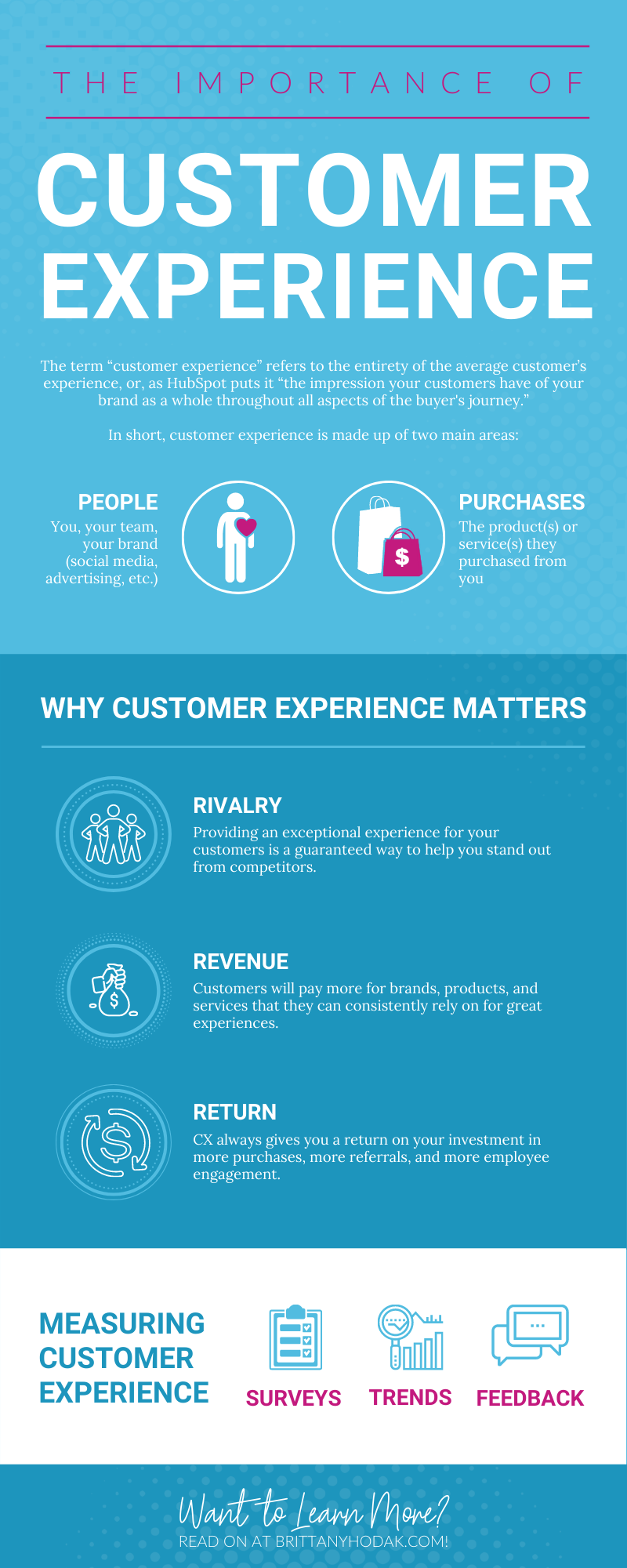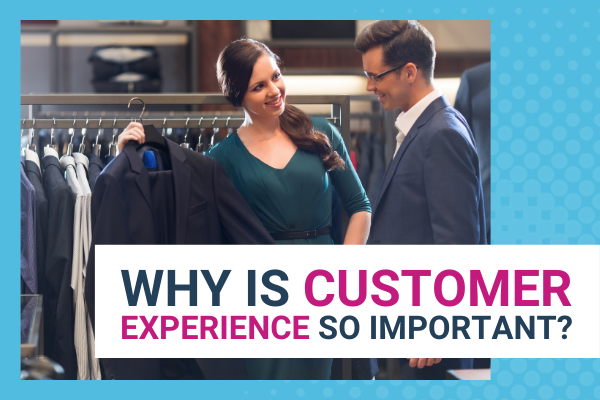When you see the prompt, “Name a few of your favorite brands,” which businesses come to mind? Maybe they’re lucrative tech companies, like Apple, or maybe they’re small businesses, like your treasured local coffee shop. In either case, the way you remember experiences with certain brands over others is something many business owners want for their own customers, leading many to ask, “Why is customer experience so important?”.
Customer experience is important because, when well executed, there is a direct correlation to higher customer retention, more referrals, lower customer acquisition costs, and even higher profit margins overall.
Here, we’ll cover each of these results in detail along with how to keep tabs on customer experience in your business. We’ll also cover a few of the ways that you – as a business owner or a member of a team – can play a part in improving it. After all, the better a customer’s experience, the more likely they are to tell others how awesome it was, essentially doing your marketing for you. What’s not to love about that? 👍
What is Customer Experience?
First and foremost, let’s break down customer experience itself. Unsurprisingly, the term “customer experience” refers to the entirety of the average customer’s experience, or, as HubSpot puts it “the impression your customers have of your brand as a whole throughout all aspects of the buyer’s journey.”
This includes every interaction a customer has with you or a member of your team, every time they come in contact with your brand externally (social media, advertising, etc.), and every time they make use of the product or service they purchased from you. In short, customer experience is made up of two main areas: people and purchases. How a customer feels when they interact with the people on your team and the products or service they purchase from them determines the quality of their experience, as a whole.
For example, if a customer is blown away by your customer support and the quality of your products, they’re having a great customer experience. On the other hand, if they feel ignored or are disappointed in their purchase, they’re having a…well, let’s just say a less-than-ideal customer experience.
With your own customers, every part of your business – team members, social media, advertising, products, services, etc. – should be carefully crafted and maintained so that the vast majority of your customers fall into the first category and walk away saying, “Wow! That experience was amazing.”
Why Is Customer Experience So Important?
Beyond the moral reasons to serve your customers well, what are the other benefits of providing consistently great customer experiences?
We already touched on three of the most important benefits, including higher profit margins, better customer retention, and more referrals. However, there are countless other reasons that investing in your customers (before and after their purchase) can pay off big time.
Let’s talk about a few of those details and how you can put them into practice. 👇
Your customer experience sets you apart from your competitors.
First, providing an exceptional experience for your customers is a guaranteed way to help you stand out from competitors.
Now more than ever, the vast majority of any given brand is “copy-able.” If you like a company’s branding, great! You can copy that. Like their product design? You can copy that, too! However, when it comes to your competition, the reverse is also true, and any competitor can easily “steal” aspects of your business to take potential customers away from you – except for, that is, the experience you provide those customers.
This is because customer experience is, at its core, about culture. As culture is difficult – or, in many cases, impossible – to copy, investing in it becomes a foolproof way to outshine your competitors. In fact, more than two-thirds of companies today compete with customer experience as their primary focus.
One example of this is the streaming platform Netflix. Since it was started in 1997, Netflix has steadily established a culture of listening to customer questions, concerns, and requests. Over time, this has meant changing their payment portals, adjusting their app design, and catering content to meet customer demand. Nevertheless, in the long term, this has paid off big-time, so much so that Netflix now commands more than 70% of the subscription video-on-demand (SVOD) market worldwide. That’s more than six times that of their nearest competitor, as of 2020.
Likewise, with your competitors, the best way to stand out is to build your business from the ground up. Invest in the happiness of your customers, invest in your company culture, and train every team member to deploy exceptional experiences to your customers at every point in their journey. Even if they want to, there’s no way your competitors can match that.
People will pay more for a good customer experience.
The second reason to provide an exceptional experience for your customers is because of the money. I’m not talking about the return on your investment (although we’ll get to that shortly). I’m talking about the money customers will pay for a premium experience, product, or service.
You might be thinking, “Well, the price difference can’t be that big”. But, in actuality, it can be remarkable, with some industries able to charge as much as a 16% premium on their sales offerings, according to a 2018 study.
To explain this boost in revenue, tax and business consulting firm PwC explained:
Among all customers, 73% point to experience as an important factor in their purchasing decisions, behind price and product quality. Customers are willing to pay more for the experience qualities that matter most to them. 43% of consumers would pay more for greater convenience, 42% would pay more for a friendly, welcoming experience and 65% of U.S. customers find a positive experience with a brand to be more influential than great advertising.
In other words, customers aren’t simply looking for products and services that meet – or, ideally, exceed – their expectations. Long term, they’re looking for a brand they can consistently rely on to provide amazing customer experiences and exceptional customer service. Then, once they find that brand, they’re not only willing to stick around but also pay extra, since they know their money will be put right back into making their experience even better.
Considering this, your job is to transform your brand into that brand if you haven’t already. Ask yourself, “How can I continually work to improve my customer experience?” and “What parts of my customers’ journey are already exceeding their expectations?” Then, lean into those answers, and build the habit of always working to improve.
Investing in high-quality customer experiences always pays off.
Last but not least, the third and most rewarding reason to provide an exceptional experience for your customers is the guaranteed return on your investment. Whether you’re looking at money, time, or energy, everything you’re willing to invest in your customers and their interactions with your brand will always pay off.
This is true for a number of reasons.
First, it’s 5 to 25 times more expensive to onboard new customers than it is to keep existing ones. As you’d expect, this is because of the time required to engage and educate a new customer on your offerings. Obviously, for existing customers, both of these things are already taken care of.
Second, after a single positive experience with a company, 77% of customers will recommend it to family or friends. Again, why would you expend time and energy running after new customers when your greatest marketing and sales assets are your existing superfans? All you have to do is consistently serve them well, and they will sing your praises (essentially selling for you). Win, win!
Third, consistently working to improve a company’s customer experience routinely results in rising employee engagement, too, on average by 20%. The previous two examples focused primarily on the monetary ROI from customer experience. But, for this one, it’s about time and energy, too. Happy and engaged employees are better equipped to create happy and engaged customers (i.e. your superfans). Plain and simple.
Combined, these reasons – and the many we don’t have time for in this guide – demonstrate one time-tested truth: effort pays. And the more effort you put into building an amazing experience for your customers, the more reward you’ll be able to reap in the future.
How Do You Measure Customer Experience?
By this point, we’ve covered the primary reasons to invest in your customers’ experiences. But, how do you tell where your existing customer experience needs improvement? And, perhaps more importantly, how do you track it over time, so you can continue to improve year after year?
Generally speaking, there are countless answers to this question, and, depending on who you ask, you may hear that one method of measurement is more helpful than another. Here, we’ll quickly outline three of the most commonly-cited tools to which companies credit their customer experience improvement.
Survey customers about their experiences.
Arguably the most well-known way to evaluate your customers’ experiences is to ask them directly. In other words, simply send them a survey! Ask questions like “How would you rate your experience with our company on a scale of 1 to 10?” and “What could we improve about product/service?” Then, compile the results to see where customers are happiest and where they’re left unsatisfied. Who knows? There may be simple ways to dramatically improve your customers’ journey through your sales cycle. To find out, all you have to do is ask.
Look for trends in customer support questions or tickets.
Besides customer surveys, another way to measure your team’s customer experience improvement efforts is to look at your existing data, i.e. support tickets, customer questions – those sorts of inquiries. For many companies, it’s tempting to think of these as the exception. You may even think, “Well, sure, a few people have a bad experience, but the rest are happy.” However, in reality, as many as 20% of customers say they’d complain publicly about bad support. This means that, if you ignore problems that come up repeatedly or if you try to justify them by saying “Some people are just never happy,” people will notice and, over time, all of your customers’ experiences will suffer.
To avoid this, always prioritize your support efforts and always – always – take them seriously. Like survey results, the recurring themes and topics in your support messages may just be the ticket to a better experience for your customers and, by extension, better sales for your team.
Collect suggestions for your products or services.
Lastly, if you want to improve your customers’ journey, don’t just ask what they dislike about your products or services. Ask also what you can do better. Historically, there are countless inventions and ideas that only came about because the creator asked someone outside of their area of expertise for their thoughts. To hear innovation expert and author Pagan Kennedy tell it, “A lot of ideas didn’t come from professional inventors or engineering classes. They came from people who were in a position to see a problem that needed fixing in a very personal way.”
In the same way, improving customer experience in your business doesn’t just mean looking internally. It can also mean asking others – like your customers, friends, family members, and industry colleagues – what they think and how they would do things differently. Like I said before, all you have to do is ask!
To learn more about why customer experience is so important, sign up for my five-day video course. Alternatively, for the latest and greatest CX tips, sign up for my newsletter and get them delivered to your inbox twice each month, totally free. 👍

